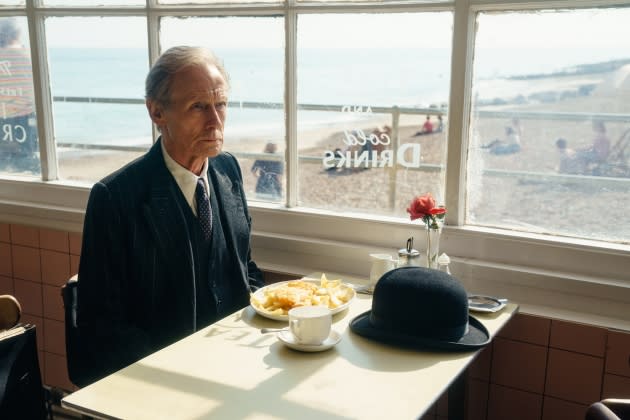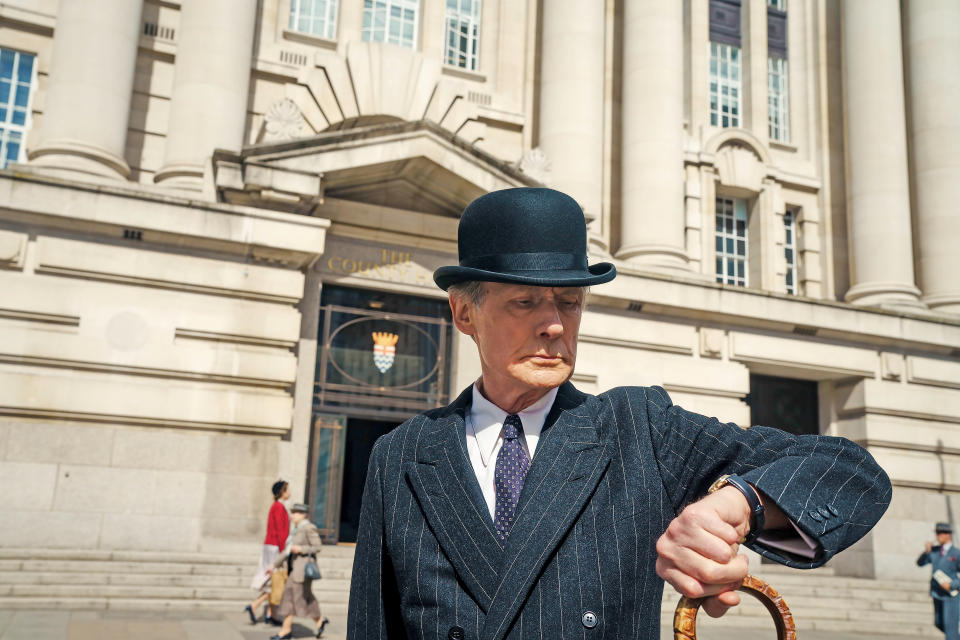‘Living’ Is Bill Nighy’s Finest Hour, and Worthy of Oscar Love
- Oops!Something went wrong.Please try again later.
- Oops!Something went wrong.Please try again later.
- Oops!Something went wrong.Please try again later.
- Oops!Something went wrong.Please try again later.

From the moment the opening credits start rolling over an overhead view of London’s Piccadilly Square, in all of its mid-20th century glory, Oliver Hermanus’ Living whisks you into a bygone era of Britain. Or, to be more specific, a lost heyday of British cinema, when names like Powell and Pressburger were synonymous with vibrancy and verve, Ealing comedies sold a vision of postwar England that prized both stiff upper lips and smirks, and movies like Brief Encounter pitted emotional repression against raging passion. The vintage font, the slightly washed tint of the color, the old-school score by the London contemporary orchestra — there are few moments where you wonder if this movie might have been recently discovered gathering dust in a vault, some lost masterpiece that even predates its source material.
That would be Ikiru, Akira Kurosawa’s 1952 drama about a bureaucrat dying of cancer who hopes to leave behind a final kindness before shuffling off this mortal coil. Long considered an outlier in the director’s career (it was made after his breakthrough Rashomon but before the samurai epics that solidified his reputation in the West, and is as quiet as those films are kinetic), it’s now recognized as a classic. Yet the film is so tied to aspects of the Japanese salaryman culture of that era that the idea of remaking it and relocating it seems counterintuitive. How do you make that work? And how do you escape the shadow of Takashi Shimura’s performance as the terminally-ill everyman, grasping at one last chance to experience the pleasures and sorrows of a life actually lived?
More from Rolling Stone
Bill Nighy Plays Florence Welch's Anxiety in Florence and the Machine's 'Free' Video
George Santos Addresses Résumé Lies on Tucker Carlson: 'I'm Not a Fraud'
We’ll start with the former: You graft this story onto an equally specific social landscape, one with its own stifling set of rules for ways to act, what things are to be left unsaid, which emotions are to be tamped down or smothered in the name of civility. It turns out that early ’50s Britain beautifully fits the bill — who would have guessed, besides Britons who lived through that time period, and virtually everybody else? (As some philosophers who called that country home once said: “Hanging on in quiet desperation / Is the English way.”) The story transplants well enough to remain more or less the same, with a buttoned-up civil servant named Mr. Williams (Bill Nighy) finding out that he has roughly six months to live. He indulges in a night of drunken revelry with a resort-town roue (Tom Burke) and spends afternoons in the company of a younger female, Margaret (Aimee Lou Wood), who used to work with him. Williams manages to get a longstanding proposal for a playground, which had been mired in red tape, passed through. Then our man exits, stage left.
The trick that Hermanus and his top-tier crew pull, however, is not to just set Living in a United Kingdom of yesteryear but makes you feel like you’re watching something that actually played in a British theater in 1952. The ye olde Golden Age credits sequence is merely the tip of the retro iceberg, and it’s possible to simply bask in the time-machine stylistics of it all. The South African director has a love for God’s-eye view shots and geometric patterns, which makes several compositions — notably a shot of commuters walking over a railway bridge while train tracks cut across the screen diagonally below them — worthy of being hung on museum walls. Sandy Powell’s costumes and Helen Scott’s production design don’t conjure a past age so much as outright resurrect it. Jamie Ramsay’s cinematography is somehow both lush and stark; bits of color contrast against loads of charcoal grays and pinstriped blacks, while shadows can either heighten a space or add to a workplace’s drabness. It’s odd to call a screenplay “elegant,” but that’s the first word that comes to mind in terms of writer Sir Kazuo Ishiguro’s contributions — the Nobel Prize-winning novelist has an impeccable ear for the speech patterns of the period’s films and the way that words can illuminate or obscure.
All of which would make this drama a perfect example of a meticulously reconstructed movie-movie, if that was the only thing it offered. These elements are also in the service of aiding and abetting a performance, however, which is what genuinely makes Living vital and unmissable. Bill Nighy has been a steadily working actor since the late 1980s, and possesses the kind of presence that can adapt itself to a prestige Brit-TV series and a Pirates of the Caribbean entry. You need stolid or silly, U.K. division, you call Nighy. Even those who hate Love Actually admit he’s the most buoyant, funny-anarchic part of it.
So much of his withdrawn, closed-off Mr. Williams is reflected through others’ impressions at first: Wakeling (Alex Sharp), the young office newbie who views the older man with awe; their department’s other bowler-hatted coworkers; Williams’ son (Barney Fishwick) and daughter-in-law (Patsy Ferran), eager to get the family house; Margaret, who views him with both affection and worry; and Burke’s boho gadfly, who takes Williams’ meds off his hands, then takes him out for a night on the town. He can be imposing or aloof, untouchable or pathetic, put-upon or paternal — it depends on who he’s talking to at any given moment.

Yet it’s Nighy who inevitably begins to guide us gently through Williams’ inner life of quiet desperation, perpetually on the verge of being self-muted entirely, and that’s when you become aware of exactly how great an actor he truly is. At one point, a quick litany of flashbacks involving youth, compromise and loss play out against nothing but the actor’s reactions; each small shift in his expression moves you along the line of his memories. He lets you see how hard it is for this person to open up, and how much or how little the curtain is pulled back in each scene. Nighy can let Williams blow off his deteriorating condition out of socially acceptable politeness (“such a bore” is his go-to description for the diagnosis) or he can gently rage against the dying of the light without giving the game away. He can make a tiny flick of a smile feel like a sunbeam, or he can turn a drunken rendition of a Scottish folk song into something heartbreaking. Keep tissues on hand for that sequence.
And it’s the star himself who, even more than the decor and the change of cultural scenery, lifts Living out of the realm of a remake and into something far more profound. It becomes another story of a man at long last learning how to embrace the world, yet one that is completely substantial and shattering and, yeah, even life-affirming on its own. The performance lifts it above and beyond. By the time the movie pays homage by replicating Ikiru’s most famous shot of an old man on a swing, totally alive for the first time, Nighy makes you feel like the nod is earned. It’s a testament to the power of one “small” man, doing one “small” thing that will benefit those he leaves behind. And, even more strikingly, to the talent of one giant actor, turning something dialed down to less into something so very much more.
Best of Rolling Stone

